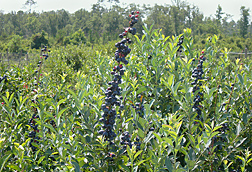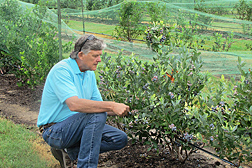New Blueberry Varieties Being Readied for Sale
|
|
Blueberry growers and consumers alike stand to benefit from Gupton and Pearl, two new southern highbush cultivars developed by Agricultural Research Service researchers in Poplarville, Mississippi. In addition to high yields of plump, flavorful berries and vigorous growth, the new cultivars should give southern growers a jump on the lucrative early-ripening fresh market, which starts in April and May.
“There’s been limited acreage of southern highbush blueberries because their lack of vigor has made them difficult to grow. However, we’ve overcome that problem to a large extent by developing hybrids from crosses made among southern highbush germplasm showing greater adaptation to the southeastern United States,” says Stephen Stringer, a geneticist at ARS’s Thad Cochran Southern Horticulture Laboratory in Poplarville.
Gupton and Pearl, released in 2006 and 2010, respectively, are finding their way into crop fields and nurseries as more propagative material becomes available from tissue-culture operations and softwood cuttings.
“Several nurseries have requested Pearl, and there are some growers in Mississippi who have Gupton in small plots in their fields. Gupton’s also being evaluated in some trials in North Carolina and other southern states and is looking very good,” reports Stringer. He collaborated on the cultivars’ development and testing with ARS horticulturists Donna Marshall and James Spiers (retired) and ARS small-fruits breeder Arlen Draper (retired).
Southern production of blueberries, both for fresh and frozen (processing) markets, is situated in the Gulf Coast states of Mississippi, Florida, Alabama, and Texas, and the Carolinas and Georgia. In 2002, for the first time, consumer demand for fresh blueberries overtook that of frozen blueberries nationwide and has since retained its lead, with Americans consuming 1.1 pounds per person in 2010 versus 0.6 pounds for frozen berries.
Michigan, Maine, New Jersey, and other northern states lead U.S. cultivated blueberry production, valued at nearly $590 million, but year-round demand for the antioxidant-rich fruit has given southern growers a chance to enter the fray, especially the early-ripening fresh market. Gupton and Pearl are the latest southern highbush blueberries to emerge from the Poplarville program with that market squarely in mind, says Stringer. Prior to release, both cultivars underwent several years of field evaluation in south-central Mississippi for vigor, yield, berry quality, splitting resistance, and other traits.
In trials, Gupton and Pearl flowered in mid to late March and were ready for harvest about 21 days before the earliest ripening rabbiteye cultivars, which have been the predominant type grown in the South. Gupton and Pearl produce medium to large, flavorful berries with light-blue color and a high soluble-solids content. The cultivars grow as sturdy, upright shrubs and have a chilling requirement (necessary for springtime blooms) of 400 to 500 hours at temperatures below 45°F.
In addition to the highbush releases, the Poplarville team is readying specialty cultivars for various niche markets, including U-pick farms and bakers, and cultivars with jumbo-sized berries weighing nearly 5 grams.
“We also released Prince, an early-ripening rabbiteye that can be harvested 7-10 days sooner than existing rabbiteyes,” adds Stringer.—By Jan Suszkiw, Agricultural Research Service Information Staff.
This research is part of Plant Genetic Resources, Genomics, and Genetic Improvement (#301) and Crop Production (#305), two ARS national programs described at www.nps.ars.usda.gov.
Stephen Stringer and Donna Marshall are with the USDA-ARS Southern Horticultural Research Laboratory, 810 Hwy. 26 West, Poplarville, MS 39470; (601) 403-8768 [Stringer], (601) 403-8762 [Marshall].
"New Blueberry Varieties Being Readied for Sale" was published in the August 2012 issue of Agricultural Research magazine.








